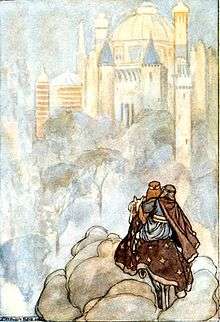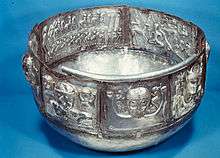Tír na nÓg
| Tír na nÓg | |
|---|---|
| Irish mythology location | |
| Type | Otherworld |
| Notable characters | Oisín, Niamh |
In Irish mythology and folklore, Tír na nÓg ([tʲiːɾˠ n̪ˠə ˈn̪ˠoːɡ]; "Land of the Young") or Tír na hÓige ("Land of Youth") is one of the names for the Otherworld, or perhaps for a part of it. It is depicted as a supernatural realm of everlasting youth, beauty, health, abundance and joy.[1] Its inhabitants are the Tuatha Dé Danann, the gods of pre-Christian Ireland.[1] In the echtrae (adventure) and immram (voyage) tales, various Irish mythical heroes visit Tír na nÓg after a voyage or an invitation from one of its residents. They reach it by entering ancient burial mounds or caves, or by going under water or across the sea.[1]
Other Old Irish names for the Otherworld include Tír Tairngire ("Land of Promise/Promised Land"),[1][2] Tír fo Thuinn ("Land under the Wave"),[1] Mag Mell ("Plain of Delight/Delightful Plain"),[1] Ildathach ("Multicoloured place"),[3] and Emain Ablach (the Isle of Apple Trees).

Tradition
Tír na nÓg is best known from the tale of Oisín and Niamh.[4] In the tale, Oisín (a human hero) and Niamh (a woman of the Otherworld) fall in love. She brings him to Tír na nÓg on a magical horse that can travel over water. After spending what seems to be three years there, Oisín becomes homesick and wants to return to Ireland. Niamh reluctantly lets him return on the magical horse, but warns him never to touch the ground. When he returns, he finds that 300 years have passed in Ireland. Oisín falls from the horse. He instantly becomes elderly, as the years catch up with him, and he quickly dies of old age.[3]
Similar tales
This story of Oisín and Niamh bears a striking similarity to many other tales, including the Japanese tale of Urashima Tarō.[5] Francis Hindes Groome recorded another such tale in his Gypsy Folk Tales.[6] Another version concerns King Herla, a legendary king of the ancient Britons, who visited to the Otherworld, only to return some two hundred years later after the lands had been settled by the Anglo-Saxons. The "Seven Sleepers of Ephesus", a group of Christian youths who hid inside a cave outside the city of Ephesus around 250 AD, purportedly awoke approximately 180 years later during the reign of Theodosius II.
Related concepts
See also
- Irish mythology in popular culture: Tír na nÓg
- Annwn
- Avalon
- Fairyland
- Fortunate Isles
- Hy Brasil (mythical land)
- Tir Na Nog (video game)
- Mystic Knights of Tir Na Nog TV series
References
- 1 2 3 4 5 6 Koch, John T. Celtic Culture: A Historical Encyclopedia. ABC-CLIO, 2006. pp.1671
- ↑ James MacKillop (1998). A dictionary of Celtic mythology Oxford University Press.
- 1 2 Monaghan, Patricia. The Encyclopedia of Celtic Mythology and Folklore. Infobase Publishing, 2004. pp.358, 368
- ↑ T.A. Rolleston (1990). Celtic Myths and Legends Courier Dover Publications.
- ↑ Shah, Idries (1991). World tales : the extraordinary coincidence of stories told in all times, in all places. London: Octagon. p. 359. ISBN 978-0863040368.
- ↑ http://www.sacred-texts.com/neu/roma/gft/gft074.htm
